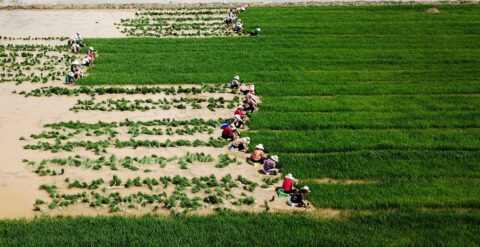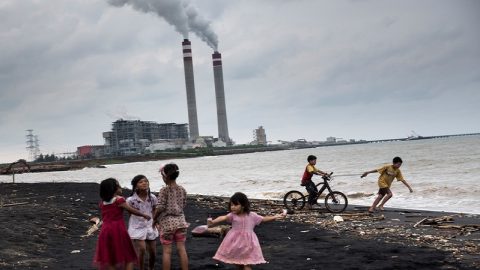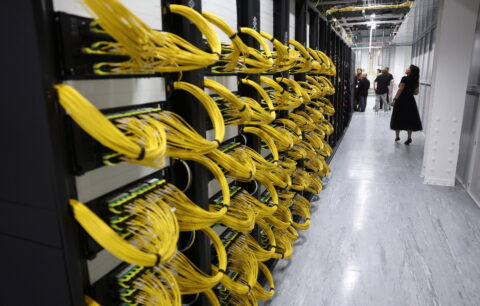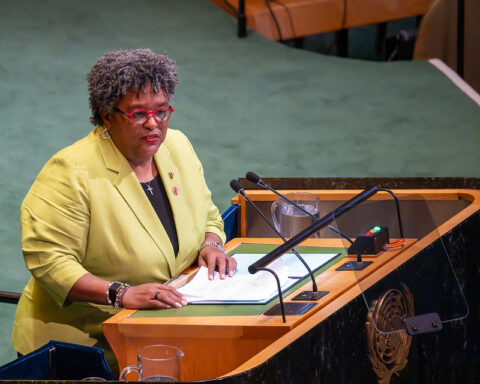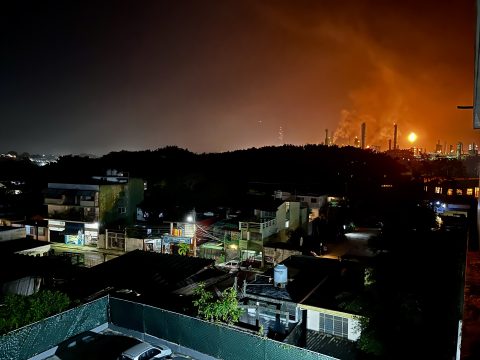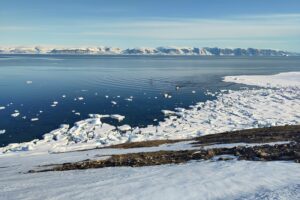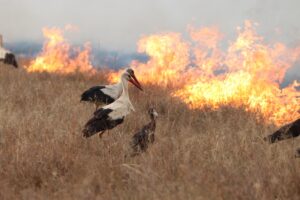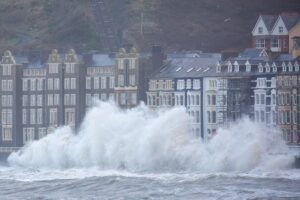Alison Shaw is with the Clean Shipping Coalition; Natacha Stamatiou is head of IMO engagement on reducing emissions for the Environmental Defense Fund; Jamie Yates is climate and renewable energy manager for Pacific Environment; and Mark Lutes is senior advisor for global climate policy at WWF.
This year marks an important milestone for global climate diplomacy, with the United Nations finally taking action on one of the world’s biggest polluters: international shipping.
In April 2025, governments reached a historic agreement at the UN’s shipping arm – the International Maritime Organization (IMO) – on the Net-Zero Framework.
The policy will be the world’s first and binding global emission pricing on any sector. For organisations like ours that have been following the IMO debates for several years, this result was proof that climate multilateralism is still alive and can deliver meaningful action.
What makes the Net-Zero Framework unique is that it includes an emission pricing element requiring shipping companies to pay a penalty fee for failing to comply with carbon intensity targets for the energy they use on ships. These penalties are projected to generate $10–15 billion annually from 2028 in climate finance.
Yet, while the policy’s adoption in October will mark a breakthrough, critical details that still remain to be decided will make or break this flagship climate law before it enters into force in 2027.
The most contentious issue yet to be finalised is which types of energy will be incentivised on ships as alternatives to fossil fuels – in other words, which alternative fuels will be recognised as delivering genuine, deep emissions reductions.
Gas and biofuel risk
The Framework is currently “fuel neutral,” meaning that all fuel types could qualify, regardless of their actual climate performance. This opens the door to cheap but harmful solutions, like high-risk biofuels and fossil gas, known as Liquefied Natural Gas (LNG).
High-risk biofuels, like much of those derived from soy and palm oil, are especially concerning. Their production all too often is linked to deforestation, violation of land rights, especially for Indigenous peoples and customary landowners, water stress, and food insecurity, and in some cases, even higher emissions than fossil fuels.
The scale of the problem is quite staggering and the consequences could be disastrous for global food security and soil health worldwide. A study has estimated that satisfying shipping’s biofuel demand could require up to 35 million hectares of land by 2030 – an area roughly the size of Germany – and consume the equivalent of 300 million bottles of vegetable oil per day.
The impacts of high-risk biofuels have already been felt in communities and lands in Latin America, where expansion of soy production is the second-largest driver of deforestation. In South-East Asia, 45% of palm oil plantations have occupied previously forested land and have expanded by 370% between 1990 and 2023. Communities in these regions bear the brunt, often losing their land and livelihoods in the process.
Quantitative accounting
A safeguard against these harms is to quantitatively account for indirect land-use change (ILUC) emissions. ILUCs occur when agricultural land is diverted to biofuel production pushing food or feed production into new areas and driving the destruction of carbon-rich ecosystems.
If ILUC emissions are ignored, cheap biofuels will inevitably flood the market making them the go-to solution for meeting the shipping climate targets, jeopardizing shipping’s climate targets.
Worse, large-scale investment in high-risk biofuels could slow the development and uptake of truly sustainable alternatives, such as green e-fuels, given the limited supply of renewable resources and investment capital.
To unlock this finance, governments should provide clear incentives for zero-emission solutions such as maximising energy efficiency and wind propulsion, batteries and solar energy, and renewable e-fuels. Only these genuinely clean alternatives will help achieve short- and medium-term climate goals while keeping transition costs down and ensuring renewable energy isn’t wasted.
Make fuel from renewables
In the long run, shipping’s decarbonisation hinges on the large-scale production and adoption of e-fuels made from renewable electricity. Growing demand for such fuels would help secure investments in future and existing projects especially in countries with strong potential for green hydrogen production, many of them located in Africa and South America.
Equally important is ensuring that the revenues generated by the Framework – billions of dollars annually – are distributed fairly. The funds must not only assist the maritime sectors of the most climate-vulnerable nations but also drive the development of resilient renewable energy infrastructure that advances the transition of the shipping sector.
This October and in the months ahead, we – the Clean Shipping Coalition, Environmental Defense Fund, Pacific Environment, and WWF – will follow the IMO’s negotiations. Our role will be to provide governments with rigorous, science-based analysis to ensure decisions are taken in the interest of the climate, biodiversity, and communities worldwide. With the right choices, the IMO can set shipping on course for a cleaner, healthier future.
The post How high-risk biofuels could sink a flagship climate law for global shipping appeared first on Climate Home News.
How high-risk biofuels could sink a flagship climate law for global shipping
Climate Change
Recent COP hosts Brazil and Azerbaijan linked to “super-emitting” methane plumes
As countries come under growing pressure to tackle planet-heating methane emissions from the fossil fuel sector, oil and gas producers in COP host nations Brazil and Azerbaijan are struggling to prevent large leaks of methane, data shared with Climate Home News shows.
Satellite observations detected “super-emitting” methane plumes in the two countries this year that were visible from space and linked to state oil companies in both cases. Brazil presided over this year’s COP30 climate talks, while COP29 was in Azerbaijan.
Methane is a greenhouse gas that traps about 80 times more heat in the atmosphere than carbon dioxide but has a shorter life span. If global warming is to stay below 1.5C, the International Energy Agency (IEA) estimates that methane emissions from fossil fuels would need to fall by 75% by 2030.
At COP26 in 2021, a group of more than 100 countries announced their intention to cut methane emissions across all sectors by 30% from 2020 levels by the end of this decade. But a UN Environment Programme (UNEP) assessment shows they are instead set to rise 5% by 2030.
At COP30 this November, Brazil’s Environment Minister Marina Silva said that reducing methane emissions “gives us an opportunity to keep the planet’s average temperature [rise] within 1.5C, decreasing the frequency, intensity and impact of extreme weather events and protecting lives”.
And last year, Rovshan Najaf, president of Azerbaijan’s state oil company SOCAR, promised that the firm would achieve near-zero methane emissions in its oil and gas production by 2035.
However, the latest data available from Azerbaijan’s SOCAR shows that the company’s methane emissions more than tripled from 2023 to 2024, when the country hosted COP29. SOCAR identified about 200,000 tonnes of methane emissions from its business activities in 2024.
Brazilian state-oil company Petrobras, meanwhile, did manage to reduce its methane emissions by more than half between 2015 and 2022, but they have since stayed stagnant, at about a million tonnes of CO2-equivalent emitted per year, the company’s annual sustainability data shows.
“Reducing methane has significant impacts on a country’s ability to meet its climate commitments,” said Tengi George-Ikoli, a methane expert with the National Resource Governance Institute (NRGI).
“Countries like Brazil and Azerbaijan, who have hosted COPs, should be seen to commit to those efforts more so than others,” she emphasised.
In 2025, UNEP’s International Methane Emissions Observatory (IMEO) alerted countries globally – including Brazil and Azerbaijan – to around 2,200 instances linking their oil and gas production to super-emitting events.
Both Brazil and Azerbaijan have focal points that receive these IMEO alerts. But a recent report shows that 90% of the notifications did not even receive a response, and neither Brazil nor Azerbaijan are listed in the 25 successful cases that managed to reduce emissions thanks to this system.
Big plumes in Azerbaijan’s southern oil & gas hub
In Azerbaijan, persistent large-scale methane emissions have been detected over its southern coast – a hub for its oil and gas industry – during the past two years, according to satellite data from online monitoring platform Carbon Mapper.
When satellites passed over the region in mid-2024, as Azerbaijan prepared to host the COP29 climate summit, they spotted a handful of massive methane plumes, each releasing between 2,000 and 4,000 kilogrammes of methane per hour, dozens of times above the threshold for a “super-emitting” event.
According to Carbon Mapper’s data, methane emissions from the same locations still persisted a year later at comparable or even higher levels.

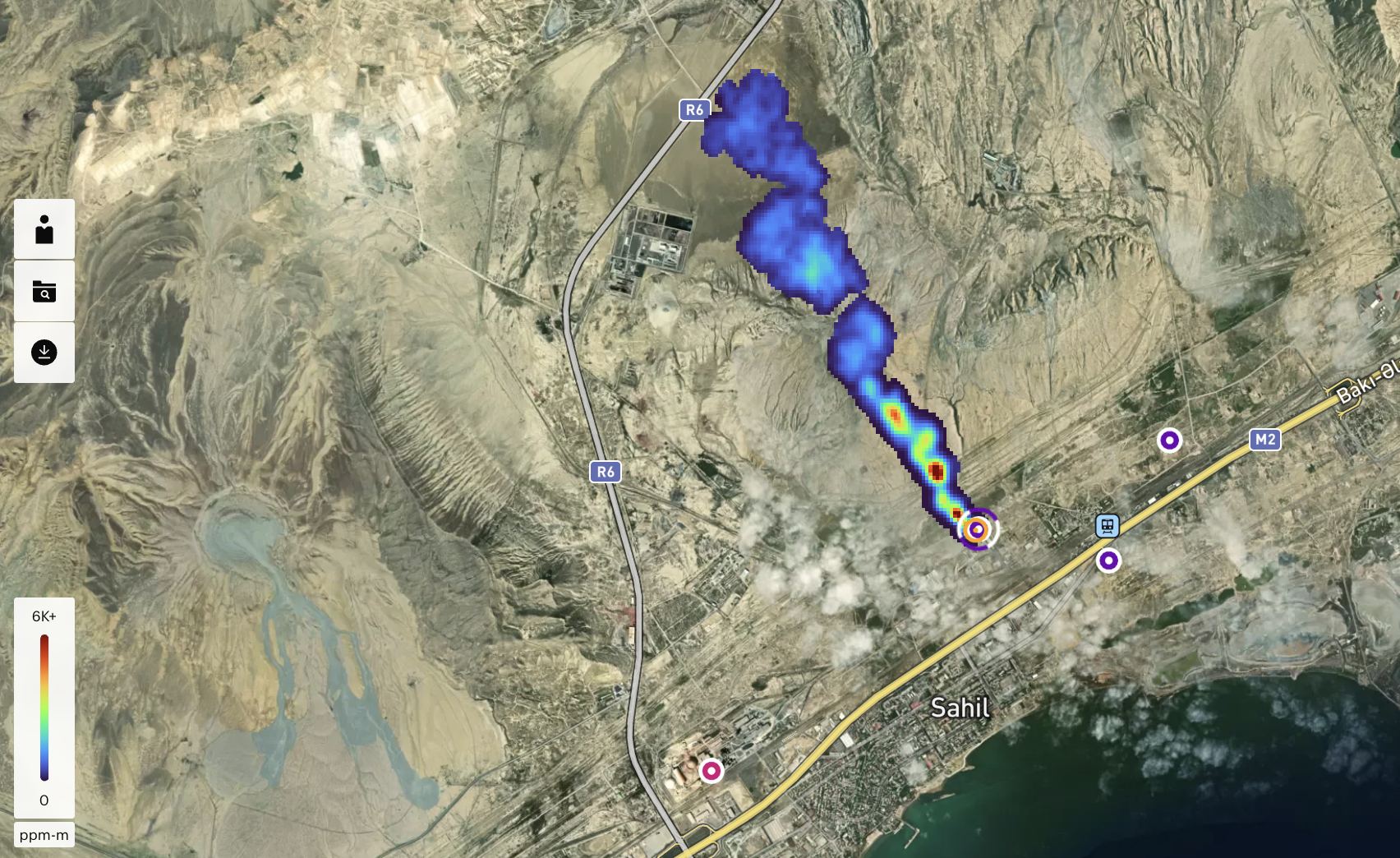


It is impossible to pinpoint precisely the source of those emissions without ground-level monitoring. But satellite data suggests that methane was released both from pipelines – which may be leaking – and compressor stations, which are facilities that help keep fossil gas flowing by boosting its pressure.
Throughout this year, large methane plumes have been observed by satellites emanating from a facility run by SOCAR in one of the world’s oldest oil fields, located just a few miles from Baku’s swanky waterfront boulevard.
In its 2025 sustainability report, SOCAR said it had expanded its methane emissions monitoring by using “leak detection AI tools”, drones and satellite technologies that “enabled more targeted, data-driven responses and supported the development of effective mitigation measures across operational sites”.
State oil firm in COP30 host nation linked to leaks
In Brazil, state-oil company Petrobras has been linked to three methane “super-emitting events” detected by satellites this year, which raises questions about emissions from its offshore oil and gas production facilities.
Three large methane plumes were detected in the Santos basin off the coast of Rio de Janeiro – which holds several of Brazil’s largest oil and gas fields – by Carbon Mapper on April 23.
Further analysis by environmental nonprofit SkyTruth, which specialises in satellite observations, revealed the plumes came from vessels in the Tupi field, which is majority-owned by Petrobras. Two of the vessels are operated by Dutch company SBM and the other by Petrobras.
The plumes in the Santos basin were large enough to be considered “super-emitting” methane events, on a scale similar to leaks in the same category detected in other parts of the world.
The US Environmental Protection Agency defines these as events with a rate of emissions of 100 kg of methane per hour. Two of the plumes detected in Brazil were above 300 and one was above 700 kg of methane per hour.
The events in Brazil are “particularly stunning” and could point to a more persistent issue, SkyTruth’s CEO John Amos told Climate Home, because the three plumes were detected during just one observation by a satellite orbiting the area.
“For one attempt to produce three positive plumes suggests that this could be a systematic problem offshore,” he said.
Petrobras says mitigation measures in place
Asked about these cases, Petrobras told Climate Home in a statement that the company is committed to reducing methane emissions as part of its decarbonisation strategy. It added that, because the plumes were detected by a single satellite observation, “the ability to draw broader conclusions about the consistency and magnitude of emissions over time is limited”.
The company also highlighted that its assets in the Santos basin perform “within the industry’s first quartile” for emissions per barrel of oil and noted that “initiatives such as recovering flare gas and performing leak detection and repair campaigns have helped to mitigate methane emissions”.
Petrobras also said that “during the period in question, operational conditions were under normal circumstances”.
Amos argued that if the sector considers such super-emitter plumes of methane – observable from space – “to be a consequence of ‘normal operating conditions’, then the offshore methane problem may be far worse than we anticipated”.
Just days before COP30, Petrobras executives co-chaired an offshore oil and gas conference in Rio de Janeiro. The discussions, the organisers wrote in a welcome letter, would focus on “traditional oil and gas technologies while highlighting the innovations essential for a more sustainable future” and would be “strategically positioned amid the ongoing energy transition”.
Barbados PM proposes binding methane pact
As global greenhouse gas emissions have continued to rise, with the United Nations admitting in November that an overshoot of the 1.5C warming limit is now inevitable, action on methane garnered growing attention at COP30.
New initiatives were launched at the climate summit in Belém to tackle methane emissions from the production of fossil fuels, which accounts for about a third of global emissions from this “super pollutant”, with other key sources being agriculture and waste management.
The UK launched a declaration to “drastically reduce” methane from the fossil fuel sector, which was endorsed by 11 countries including major oil and gas producers Canada, Norway and Kazakhstan. The actions it supports include more transparent monitoring, eliminating routine flaring and venting, and tracking progress towards near-zero methane emissions per unit of production.
The UK and Brazil also launched a three-year $25-million funding package to help developing countries tackle methane, among other “super pollutant” gases, which will benefit a first cohort of mostly fossil fuel-producing countries – among them Brazil, Kazakhstan, Mexico and Nigeria.
At last year’s COP29, the European Union championed an initiative that encouraged fossil fuel-producing countries to create roadmaps towards abating methane emissions from coal, oil and gas, including timelines, investment needs and the amount of emissions to be abated.
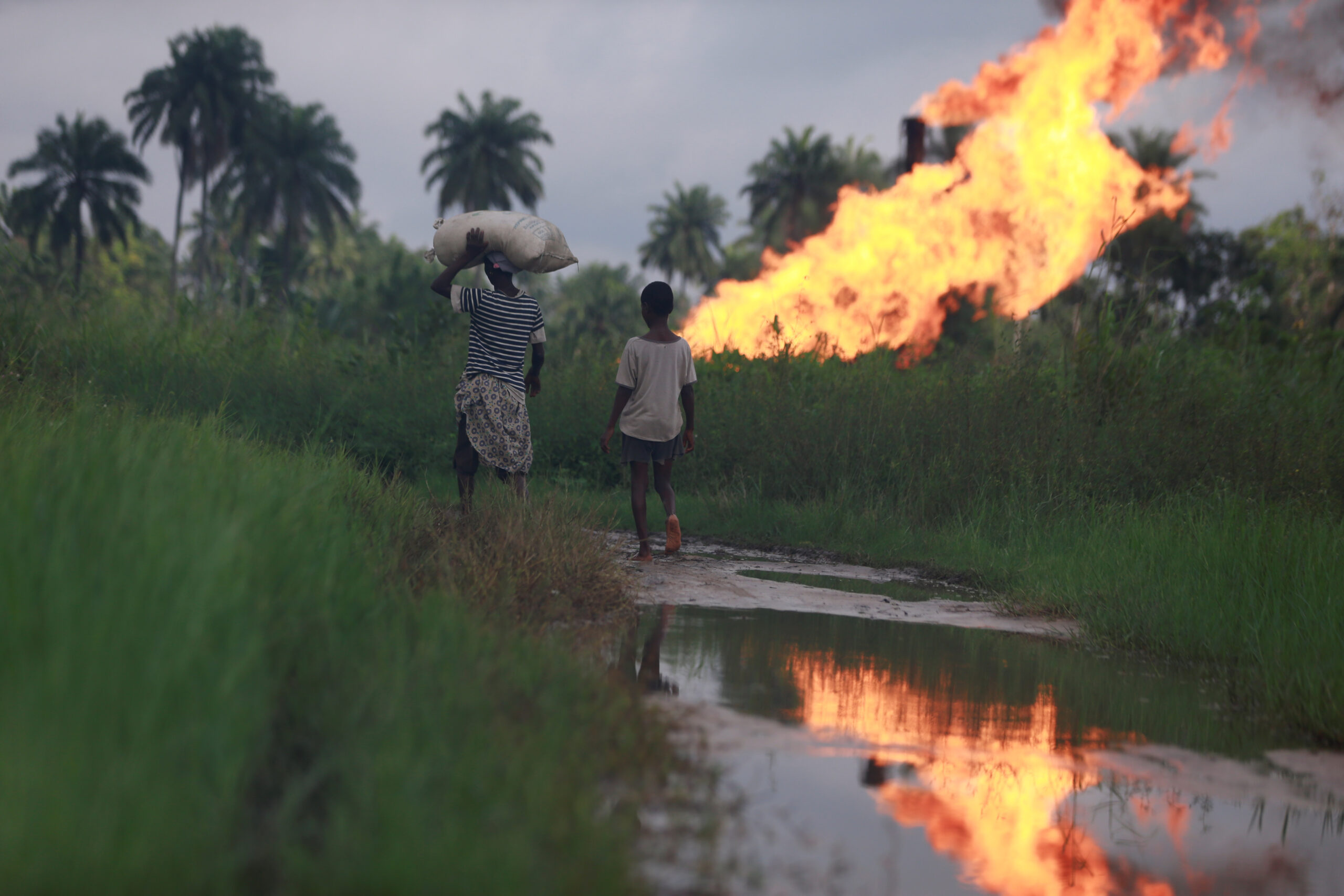

But, as a growing clutch of voluntary initiatives has failed to produce results at the scale and speed needed to rein in global warming in the short term, pressure is rising for a more accountable and comprehensive approach to the problem.
At COP30, Barbados’ Prime Minister Mia Mottley renewed her call for a legally binding methane pact to “pull the methane emergency brake” and “buy us some time”, starting with actions in the oil and gas industry.
NRGI’s George-Ikoli said the oil and gas sector could lead on cutting methane emissions because measures like zero flaring and venting, and eliminating leaks could bring in revenues for companies by enabling them to use or sell currently wasted gas.
Mottley wrote in an op-ed for The Guardian this month that the next step would be to convene heads of state from willing nations to develop “a roadmap in 2026 for binding measures for the oil and gas industry”. Negotiations could start by 2027, with a deal adopted “as soon as possible thereafter”, she proposed.
The post Recent COP hosts Brazil and Azerbaijan linked to “super-emitting” methane plumes appeared first on Climate Home News.
Recent COP hosts Brazil and Azerbaijan linked to “super-emitting” methane plumes
Climate Change
Guest post: How to steer EVs towards the road of ‘mass adoption’
Electric vehicles (EVs) now account for more than one-in-four car sales around the world, but the next phase is likely to depend on government action – not just technological change.
That is the conclusion of a new report from the Centre for Net Zero, the Rocky Mountain Institute and the University of Oxford’s Environmental Change Institute.
Our report shows that falling battery costs, expanding supply chains and targeted policy will continue to play important roles in shifting EVs into the mass market.
However, these are incremental changes and EV adoption could stall without efforts to ensure they are affordable to buy, to boost charging infrastructure and to integrate them into power grids.
Moreover, emerging tax and regulatory changes could actively discourage the shift to EVs, despite their benefits for carbon dioxide (CO2) emissions, air quality and running costs.
This article sets out the key findings of the new report, including a proposed policy framework that could keep the EV transition on track.
A global tipping point
Technology transformations are rarely linear, as small changes in cost, infrastructure or policy can lead to outsized progress – or equally large reversals.
The adoption of new technologies tends to follow a similar pathway, often described by an “S-curve”. This is divided into distinct phases, from early uptake, with rapid growth from very low levels, through to mass adoption and, ultimately, market saturation.
However, technologies that depend on infrastructure display powerful “path-dependency”, meaning decisions and processes made early within the rollout can lock in rapid growth, but equally, stagnation can also become entrenched, too.
EVs are now moving beyond the early-adopter phase and beginning to enter mass diffusion. There are nearly 60m on the road today, according to the International Energy Agency, up from just 1.2m a decade ago.
Technological shifts of this scale can unfold faster than expected. Early in the last century in the US, for example, millions of horses and mules virtually disappeared from roads in under three decades, as shown in the chart below left.
Yet the pace of these shifts is not fixed and depends on the underlying technology, economics, societal norms and the extent of government support for change. Faster or slower pathways for EV adoption are illustrated in the chart below right.
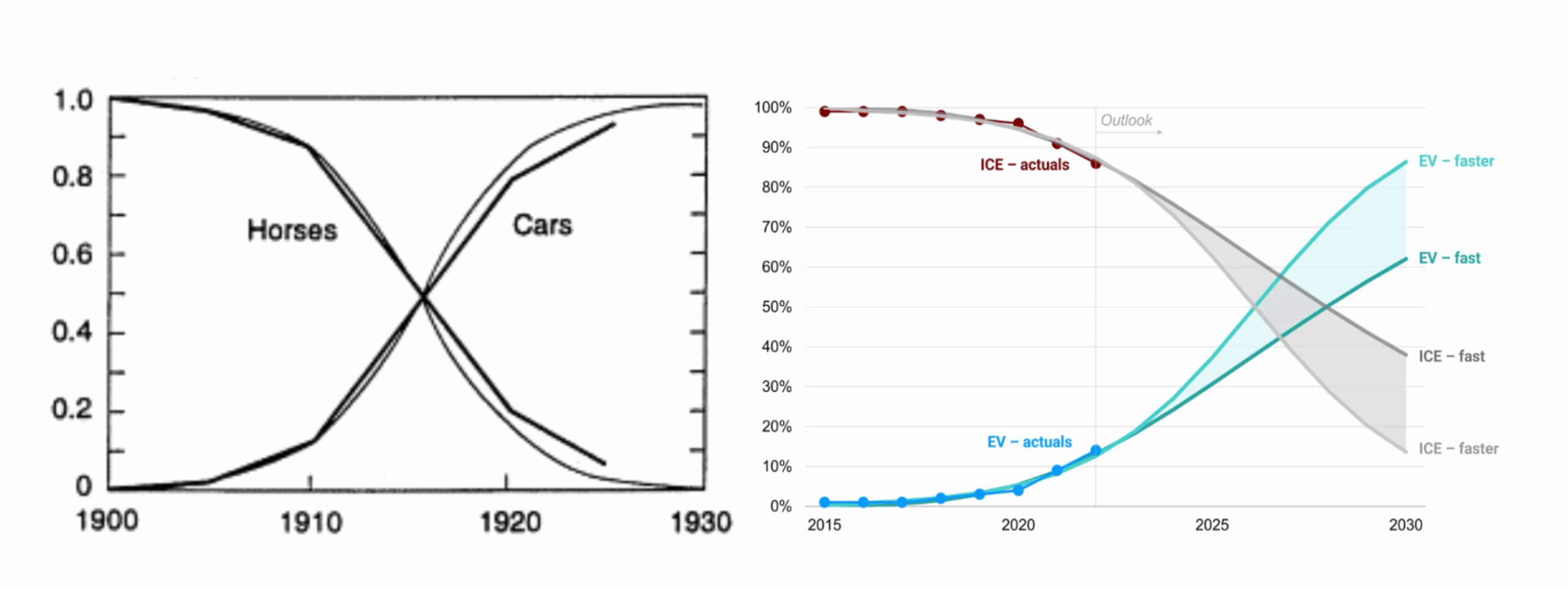
Internal combustion engine (ICE) vehicles did not prevail in becoming the dominant mode of transport through technical superiority alone. They were backed by massive public investment in roads, city planning, zoning and highway expansion funded by fuel taxes.
Meanwhile, they faced few penalties for pollution and externalities, benefitting from implicit subsidies over cleaner alternatives. Standardisation, industrial policy and wartime procurement further entrenched the ICE.
EVs are well-positioned to follow a faster trajectory, as they directly substitute ICE vehicles while being cleaner, cheaper and quieter to run.
Past transitions show that like-for-like replacements – such as black-and-white to colour TVs – tend to diffuse faster than entirely novel products.
Late adopters also benefit from cost reductions and established norms. For example, car ownership took 60 years to diffuse across the US, but just 20 years in parts of Latin America and Japan.
In today’s globalised economy, knowledge, capital and supply chains travel faster still. Our research suggests that the global EV shift could be achieved within decades, not half a century.
Yet without decisive policy, investment and coordination, feedback loops could slow, locking in fossil-fuel dependence.
Our research suggests that further supporting the widespread deployment of EVs hangs on three interlinked actions: supporting adoption; integrating with clean electricity systems; and ensuring sustainability across supply chains and new mobility systems.
Closing the cost gap
EVs have long offered lower running costs than ICE vehicles, but upfront costs – while now cost-competitive in China, parts of Europe and in growing second-hand markets – remain a major barrier to adoption in most regions.
While battery costs have fallen sharply – lithium-ion battery packs fell by 20% in 2024 alone – this has not fully translated into lower retail vehicle prices for consumers.
In China, a 30% fall in battery prices in 2024 translated into a 10% decline in electric SUV prices. However, in Germany, EV retail prices rose slightly in 2024 despite a 20% drop in battery costs.
These discrepancies reflect market structures rather than cost fundamentals. Our report suggests that a competitive EV market, supported by transparent pricing and a strong second-hand sector, can help unlock cost parity in more markets.
Beyond the sale of EVs, government policy around running costs, such as fuel duty, has the potential to disincentivse EV adoption.
For example, New Zealand’s introduction of road-pricing for EVs contributed to a collapse in registrations from nearly 19% of sales in December 2023 to around 4% in January 2024.
EV-specific fees have also been introduced in a number of US states. Last month, the UK also announced a per-mile charge for EVs – but not ICEs – from 2028.
Addressing the loss of fuel-duty revenue as EVs replace ICE vehicles is a headache for any government seeking to electrify mobility.
However, to avoid slowing diffusion, new revenues could be used to build out new charging infrastructure, just as road-building was funded as the ICE vehicle was scaling up.
While subsidies to support upfront costs can help enable EV adoption, the best approach to encouraging uptake is likely to shift once the sector moves into a phase of mass diffusion.
Targeted support, alongside innovative financing models to broaden access, from blended finance to pay-as-you-drive schemes, could play a greater role in ensuring lower-income drivers and second-hand buyers are not left behind.
Mandates as engines of scale
Zero-emission vehicle (ZEV) mandates and ICE phase-out deadlines can reduce costs more effectively than alternatives by guaranteeing market scale, our research finds, reducing uncertainty for automakers and pushing learning rates forward through faster production.
California’s ZEV mandate was one of the first in the 1990s, a policy that has since been adopted by ten other US states and the UK.
China’s NEV quota system has produced the world’s fastest-growing EV market, while, in Norway, clear targets and consistent incentives mean EVs now account for nearly all of new car sales. These “technology-forcing” policies have proved highly effective.
Analyses consistently show that the long-run societal benefits of sales mandates for EVs far outweigh their compliance costs.
For example, the UK’s ZEV mandate has an estimated social net present value of £39bn, according to the government, driven largely by emissions reductions and lower running costs for consumers.
Benefits can also extend beyond national borders. For example, California’s “advanced clean cars II” regulations – adopted by a number of US states and an influence on other countries – have been instrumental in compelling US automakers to develop and commercialise EVs, which can, in turn, trigger innovation and scale to reduce costs worldwide.
Research suggests that, where possible, combining mandates and incentives creates further synergies: mandates alleviate supply-side constraints, making subsidies more effective on the demand side.
Public charging: a critical bottleneck
Public charging is one of the most significant impediments to EV adoption today.
Whereas EVs charged at home are substantially cheaper to run than ICE vehicles, higher public charging costs can erase this benefit – in the UK, this can be up to times the home equivalent.
While most homes in the UK, for example, do have access to off-street parking, there are large swathes of low-income and urban households without access to private driveways. For these households, a lack of cheap public charging has been described as a de facto “pavement tax”, which is disincentivising EV adoption and resulting in an inequitable transition.
Our research shows that a dual-track charging strategy could help resolve the situation. Expanding access to private charging – through cross-pavement cabling, “right-to-charge” legislation for renters and planning mandates for new developments could be combined with strategic investment in public charging, to overcome the “chicken-and-egg” problem for investors uncertain about future EV demand.
Meanwhile, “smart charging” in public settings – where EV demand is matched with cheaper electricity supply – can also help close the affordability gap, by delivering cheap off-peak charging that is already available to those charging at home.
The Centre for Net Zero’s research shows that drivers respond to dynamic pricing outside of the convenience of their homes, which reduces EV running costs below those of petrol cars.
The figure below shows that, while the level of discount being offered had the strongest impact, lower-income areas showed the largest behavioural response, indicating that they may stand to gain the most from a rollout of such incentives.
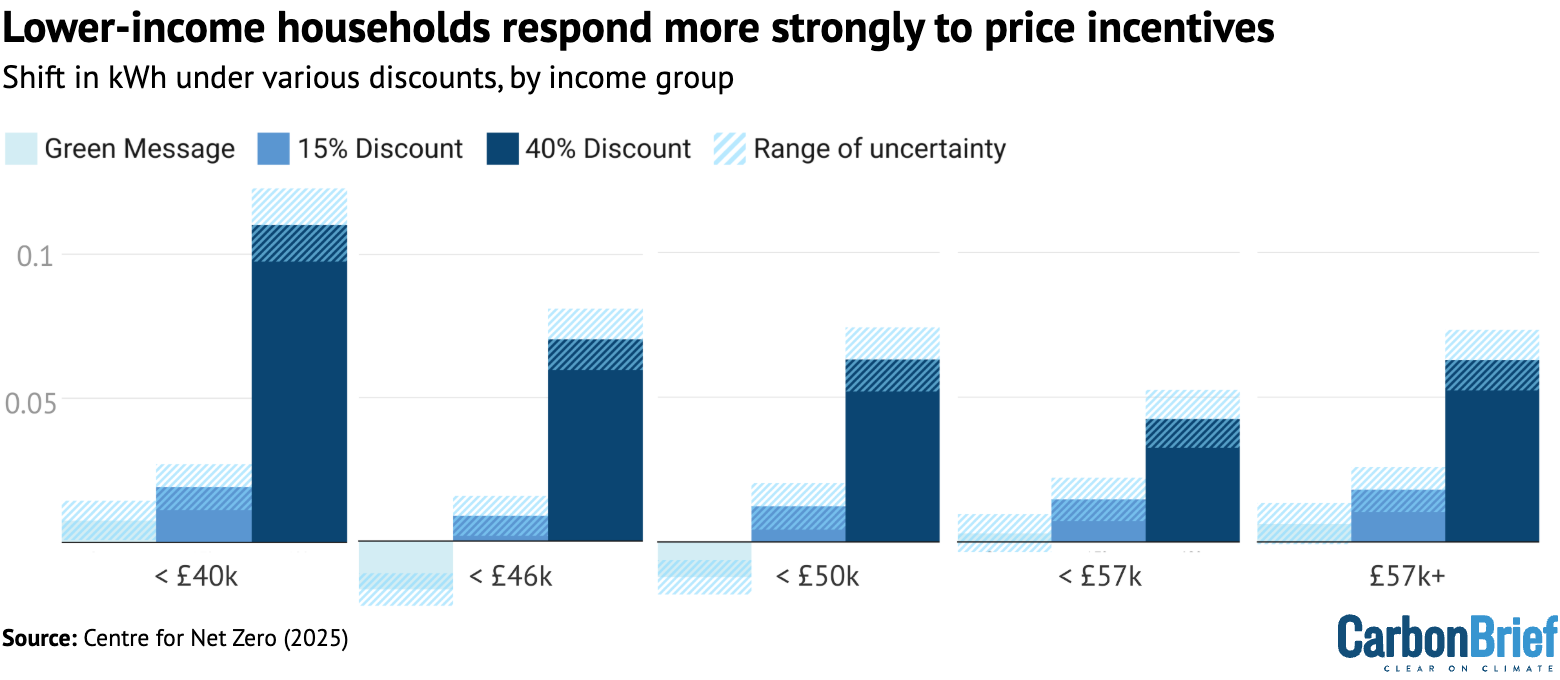
Our research suggests that policymakers could encourage this type of commercial offering by creating electricity markets with strong price signals and mandating that these prices are transparent to consumers.
Integrating with clean electricity grids
Electrification is central to decarbonising the world’s economies, meaning that sufficient capacity on electricity networks is becoming a key focus.
For the rollout of EVs, pressure will be felt most on low-voltage “distribution” networks, where charging is dispersed and tends to follow existing peaks and troughs in domestic demand.
Rather than responding to this challenge by just building out the grid – with the corresponding economic and political implications – making smart charging the norm could help mitigate pressure on the network.
Evidence from the Centre for Net Zero’s trials shows that AI-managed charging can shift EV demand off-peak, reducing residential peak load by 42%, as shown in the chart below.
Additionally, the amount of time when EVs are plugged in but not moving is often substantial, giving networks hours each day in which they can shift charging, targeting periods of low demand or high renewable output.
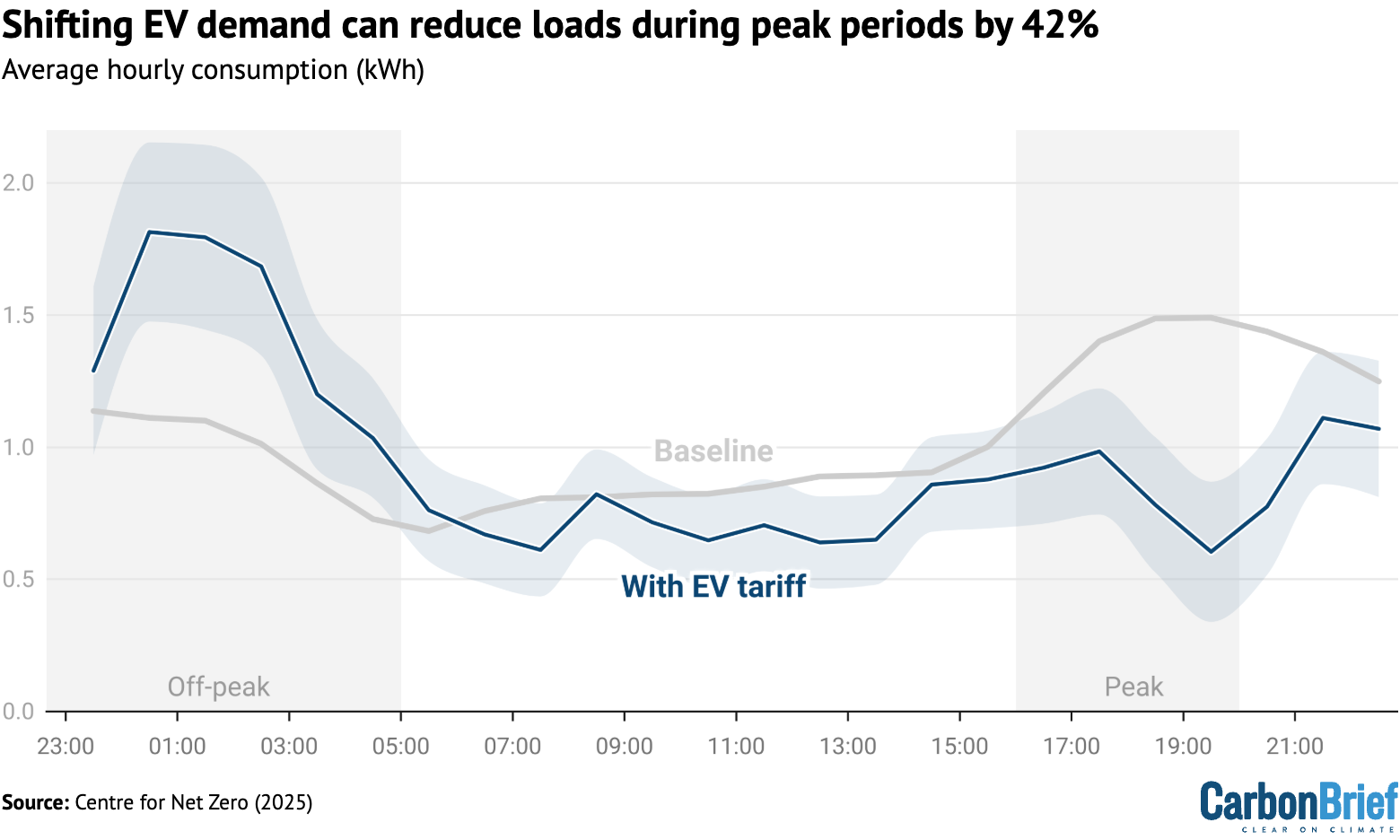
The system value of this flexible charging is significant. In the UK, managed charging could absorb 15 terrawatt hours (TWh) of renewable electricity that would otherwise be curtailed by 2030 – equivalent to Slovenia’s entire annual consumption.
For these benefits to be realised, our research suggests that global policymakers may need to mandate interoperability across vehicles, chargers and platforms, introduce dynamic network charges that reflect local grid stress and support AI-enabled automation.
Bi-directional charging – which allows EVs to export electricity to the grid, becoming decentralised, mobile storage units – remains underexploited. This could allow EVs to contribute to the capacity of the grid, helping with frequency and providing voltage support at both local and system levels.
The nascency of such vehicle-to-grid (V2G) technology means that penetration is currently limited, but there are some markets that are further ahead.
For example, Utrecht is an early leader in real-world V2G deployment in a context of significant grid congestion, while Japan is exploring the use of V2G for system resilience, providing backup power during outages. China is also exploring V2G systems.
Our research shows that if just 25% of vehicles across six major European nations had V2G functionality, then the theoretical total capacity of the connected vehicles would exceed each of those country’s fossil-fuel power fleet.
Mandating V2G readiness at new chargepoints, aligning the value of exports with the value to the system and allowing aggregators to pool capacity from multiple EVs, could all help take V2G from theory to reality.
A sustainable EV system
It is important to note that electrification alone does not guarantee sustainability.
According to Rocky Mountain Institute (RMI) analysis, the total weight of ore needed to electrify the world’s road transport system is around 1,410mtonnes (Mt). This is 40% less than the 2,150Mt of oil extracted every year to fuel a combustion-based system. EVs concentrate resource use upfront, rather than locking in fossil-fuel extraction.
Moreover, several strategies can reduce reliance on virgin minerals, including recycling, new chemistries and improved efficiency.
Recycling, in particular, is progressing rapidly. Some 90% of lithium-ion batteries could now be recycled in some regions, according to RMI research. Under an accelerated scenario, nearly all demand could be met through recycling before 2050.
Finally, while our report focuses largely on EVs, it is important to highlight that they are not a “silver bullet” for decarbonising mobility.
Cities such as Seoul and New York have demonstrated that micromobility, public transport and street redesign can cut congestion, improve health and reduce the number of overall vehicles required.
Better system design reduces mineral demand, lowers network strain and broadens access.
The ‘decision decade’ ahead
Policy decisions made today will determine whether EVs accelerate into exponential growth or stall.
Our research suggests that governments intent on capturing the economic and environmental dividends of electrified mobility are likely to need coherent, cross-cutting policy frameworks that push the market up the steep climb of the EV S-curve.
The post Guest post: How to steer EVs towards the road of ‘mass adoption’ appeared first on Carbon Brief.
Guest post: How to steer EVs towards the road of ‘mass adoption’
Climate Change
“House of cards”: Verra used junk carbon credits to fix Shell’s offsetting scandal
Verra has used nearly a million “hot air” carbon credits to compensate for bogus offsets generated by rice-paddy projects backed by energy giant Shell in China, Climate Home News can reveal.
In a case described as “shocking” and “deeply alarming” by experts, the leading carbon registry replaced 960,000 credits issued for rice-field methane reduction activities that had been found to overstate emissions cuts with an equivalent number of junk credits from other failed Chinese rice projects, its records show.
“It’s frankly unbelievable that Verra considers it appropriate to compensate for hot air credits with other hot air credits,” said Jonathan Crook, policy lead at Carbon Market Watch. “To pretend this is a satisfactory resolution is both absurd and deeply alarming.”
Shell’s links to bogus offsets
Shell is linked to both sets of projects, which Verra ruled as no longer valid in August 2024 after detecting “unprecedented” failures in their implementation. Last year, an investigation by Climate Home News and Dialogue Earth cast serious doubt on whether any emissions-cutting activities were carried out on the ground at all.
In response to those findings, a Shell spokesperson said “the projects in question are not managed or operated by Shell”. But the oil and gas major was closely involved in 10 rice-farming programmes in China as their “authorised representative” and, as Climate Home News reported last year, partly relied on their worthless carbon offsets to market “carbon-neutral” liquefied natural gas (LNG).
Regulatory filings in the US show that Shell, acting as a broker, last year offered to potential buyers the same carbon credits that have now been used as partial compensation for the 10 projects.
For more than a year, Verra failed to replace nearly 2 million worthless credits issued by the 10 projects, after the Chinese developers stopped responding to the registry’s communications with them. Shell abandoned the programmes shortly after Verra ordered that the credits should be compensated.
The credits were primarily used by Shell to offset real greenhouse gas emissions created by its vast fossil fuel operations. Other users of the phantom rice-farming offsets include Chinese state-owned fossil fuel firm PetroChina, Singapore-based DBS Bank and UK energy supplier OVO Energy.
In early October this year, updates to Verra’s registry showed that 960,000 excess credits across the 10 projects had been replaced with an equivalent number of credits drawn from four separate rice-cultivation programmes that were also axed at the same time.
Those original credits had not been voided and technically remained available to the account holder, even though Verra scrapped the underlying programmes and unsuccessfully pursued their representatives for redress. The Chinese company behind the four projects failed to respond to Verra’s requests, leaving it unclear whether the credits will ever be replaced.
Verra’s rules in the spotlight
A Verra spokesperson told Climate Home News that the account holder, “which requested to remain anonymous”, asked the registry to cancel those credits and, subsequently, Verra decided to count them towards the compensation process for the other 10 sham projects.
While Climate Home News could not verify the identity of the account holder in question, Shell declared in public filings that, in 2024, it had marketed those 960,000 credits to potential buyers.
Verra said its rules allow any active credits to be used to cover excess issuance elsewhere, even if those credits themselves need to be replaced. Commenting on this specific case involving the sham rice-farming projects, the spokesperson added: “While the source projects have been rejected and must address their own over-issuance, the credits used here were valid at the time of cancellation.”
Grayson Badgley, a research scientist at climate solutions non-profit CarbonPlan, said this sort of logic might allow Verra to balance its credit ledger but does nothing to help the planet’s atmosphere. “This isn’t just about following the rules – it’s about making sure that the carbon market supports meaningful climate action,” he added.
Compensation orders piling up
Carbon market experts told Climate Home News the case raises serious questions about Verra’s ability to safeguard the integrity of its carbon credits at a critical time when a rapidly growing number of bogus offsets require compensation.
Over 10 million worthless credits produced by the discredited Kariba forest protection megaproject in Zimbabwe, and already used by corporations to back up their green claims, need to be replaced after Verra found the threat to the forest had been exaggerated in the project’s original forecast.
Zimbabwe forest carbon megaproject generated millions of junk credits
In a separate development, Verra is now also seeking the compensation of around 4.5 million credits issued by four vast tree-planting schemes in China. The registry axed the projects last Friday after a year-long review failed to confirm they had been approved by government authorities – a key requirement – and that official documentation had not been falsified.
Shell tied to failed tree-planting schemes
While a Chinese company was in charge of the projects’ implementation, official documents show that, for years, Shell had been directly involved as an “authorised representative”. This role, which the energy giant also held in the rice paddy schemes, gave the firm all the “applicable rights and responsibilities” in relation to the activities.
Shell exited all four tree-planting projects in December 2024, a month after Verra informed the firm it would start the investigation that ultimately led to their cancellation last week.

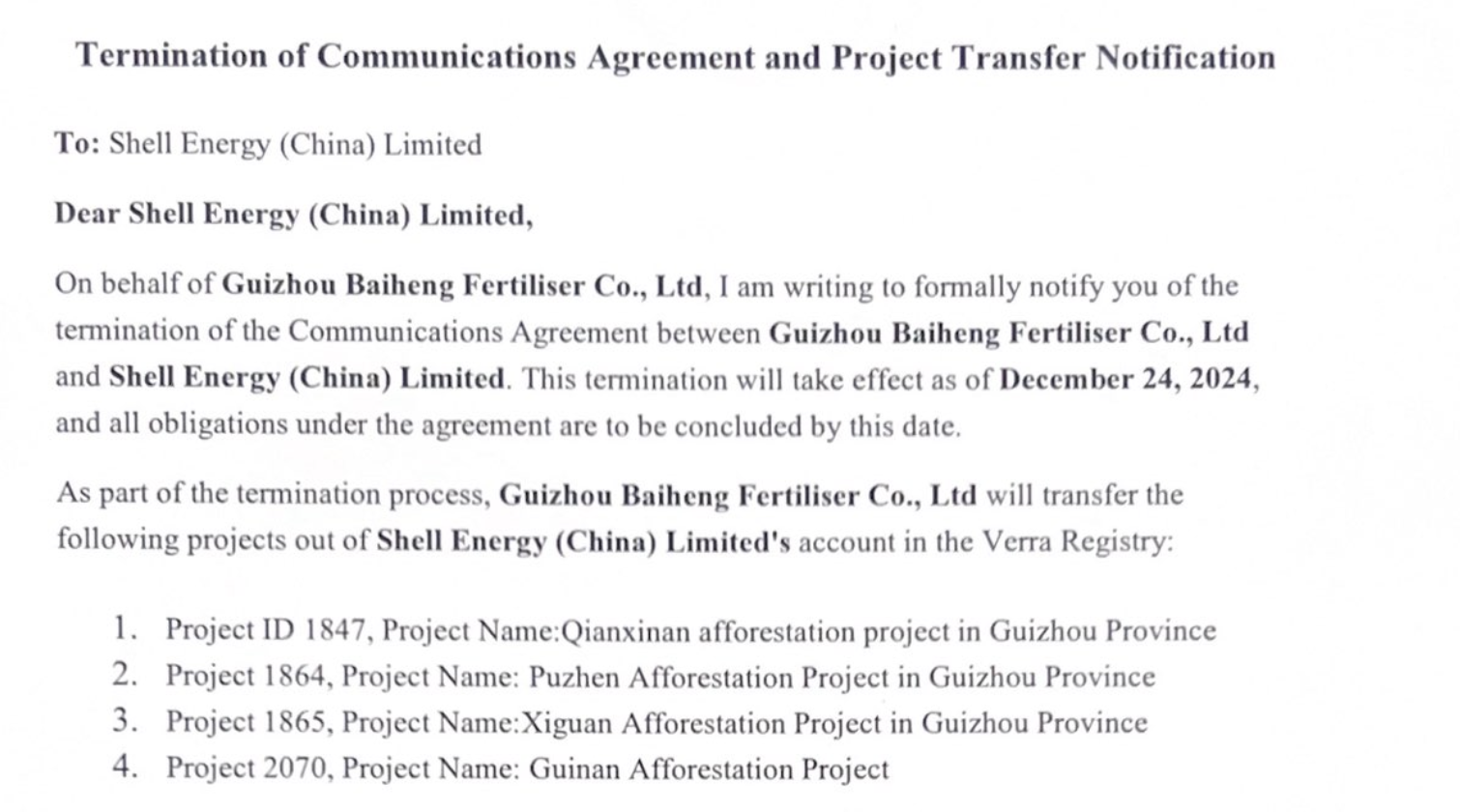


“We purchase and retire a range of Verra-certified credits and were disappointed to learn of the issues Verra identified with these projects and are looking at Verra to replace any credits that were issued under these projects,” a Shell spokesperson told Climate Home News.
For Carbon Market Watch’s Crook, Verra’s unwillingness to deal with “huge loopholes” is not only deeply troubling but also counterproductive as it undermines trust in the registry, while leaving it exposed to future misconduct by unscrupulous actors.
“Rather than take real accountability for this scandal, Verra seems intent on propping up a collapsing house of cards,” he added, referring to the compensation of rice-farming credits.
The post “House of cards”: Verra used junk carbon credits to fix Shell’s offsetting scandal appeared first on Climate Home News.
“House of cards”: Verra used junk carbon credits to fix Shell’s offsetting scandal
-
Climate Change4 months ago
Guest post: Why China is still building new coal – and when it might stop
-
Greenhouse Gases4 months ago
Guest post: Why China is still building new coal – and when it might stop
-
Climate Change2 years ago
Spanish-language misinformation on renewable energy spreads online, report shows
-

 Greenhouse Gases2 years ago
Greenhouse Gases2 years ago嘉宾来稿:满足中国增长的用电需求 光伏加储能“比新建煤电更实惠”
-
Climate Change Videos2 years ago
The toxic gas flares fuelling Nigeria’s climate change – BBC News
-

 Climate Change2 years ago
Climate Change2 years ago嘉宾来稿:满足中国增长的用电需求 光伏加储能“比新建煤电更实惠”
-

 Carbon Footprint2 years ago
Carbon Footprint2 years agoUS SEC’s Climate Disclosure Rules Spur Renewed Interest in Carbon Credits
-
Climate Change2 years ago
Why airlines are perfect targets for anti-greenwashing legal action










